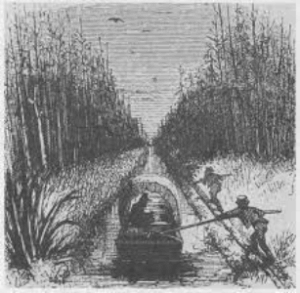Amidst the suffocating grip of slavery, the Easter Morning Slave Conspiracy sparked a flame of defiance in the heart of Virginia. In the shadows of oppression, Sancho, a humble ferry operator, dared to dream of freedom. With each beat of his heart, the flames of rebellion grew stronger, igniting a fire that would burn through the annals of history. Alongside his comrades, Sancho orchestrated the daring conspiracy of 1802, a bold endeavor to break free from the shackles of tyranny and reclaim their stolen liberty. 💪🏾
The Rivermen’s Paradox: Freedom and Captivity
Enslaved black men, hired out by slave owners, held most, if not all, of the shipping jobs in Virginia and North Carolina. By the mid-1700s, these rivermen dominated the waterways, navigating treacherous currents and bearing the weight of cargo, along with the heavier burden of their enslavement.
Their vessels became symbols of defiance, carrying not just goods, but also the aspirations of a people yearning for freedom. Yet, beneath the surface, they harbored a forbidden knowledge—a literacy in English that defied the laws of their oppressors.
In the swirling waters, the rivermen felt torn between freedom and captivity. 😞 A sense of longing mingled with the spray of the water. For the rivermen, the waterways symbolized a paradox that mirrored their own internal struggle.
Easter Morning Slave Conspiracy: A Daring Bid for Freedom
In the crisp air of fall 1801, within the quiet expanse of Halifax County, Virginia, Sancho and his fellow enslaved souls convened in secret, their hearts pulsating with the desire for liberty. Together, they conspired to defy the shackles of oppression, meticulously planning an insurrection against the white townspeople and plantation owners who held them in bondage. Little did they know that their audacious bid for freedom would go down in history as the Easter Morning Slave Conspiracy of 1802.
Sancho and the rivermen weren’t like most slaves. They could read and write, and they spread news about the rebellion by talking to each other and writing notes. They were also skilled in their jobs and knew how to blend in with white society appearing as freedmen.Sancho said they shouldn’t keep weapons. Instead, they’d grab them when they heard 🎺a trumpet, and they’d use them to destroy anyone who tried to oppress them.
The Call to Arms: Spreading the Message
Alongside his trusted companions, he enlisted a select few leaders to rally more slaves to their cause. As word spread through the canals of southern Virginia, the movement gained momentum, coursing swiftly along the river routes to northeastern North Carolina. From all directions, enslaved individuals heeded 🎺 the call, converging upon the cause. What began as a localized rebellion in Halifax County, Virginia, soon morphed into a widespread uprising, splintering into smaller factions across towns and regions. Sancho found himself at the helm of a movement far beyond his initial intentions as the tide of revolt surged beyond his control.
Revelation and Retribution
As tensions rose, White Patrollers disrupted a slave gathering, seizing handwritten notes in the process. The assembly dissolved quickly, some recruits betraying the conspiracy willingly, while others divulged details under duress. Soon, Virginia and North Carolina authorities uncovered the plot’s widespread reach across waterways.
Amidst escalating panic, enslaved individuals were rounded up en masse, facing dire consequences. Around 30 slaves faced the gallows, with many more subjected to violent reprisals by white aggressors such as cropping of ears and beatings. Only a few were spared from this brutal fate.
Legacy of Resistance
It’s fascinating to explore the history of slave rebellions and uncover how white society underestimated the Negroes’ ability to organize. Long before Sancho’s Easter Morning Slave Conspiracy of 1802, there were significant uprisings in colonial states. These included the Stono Rebellion in 1739, a revolt of 150 slaves in North Carolina in 1798, and Gabriel’s Slave Revolt in Richmond, VA in 1800. Even in the Caribbean, the Haitian Revolution (1791-1804) was in full swing, showing the widespread desire for freedom. Another notable event was the German Coast Uprising in New Orleans in 1811.
Persistence Among Adversity
Despite previous failed attempts to challenge institutional slavery, Sancho and his allies remained undeterred, embodying the adage, “If at first, you don’t succeed, try,🎺 try again.”
As the narrative of the enslaved community’s struggle for dignity unfolded, a profound shift occurred. The once-powerful slave owner, now consumed by fear of retaliation, found himself transformed from hunter to hunted, trapped within a prison of his own making.
Image credit: Engraving of black workers on the Dismal Swamp Canal from Harper’s New Monthly Magazine, XIII (September 1856), 443. (Egerton, Douglas R. “Fly across the River’: The Easter Slave Conspiracy of 1802)”

